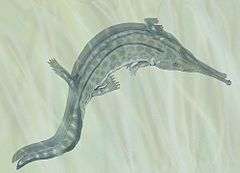Prionosuchus
| Prionosuchus Temporal range: Guadalupian, 270 Ma | |
|---|---|
 | |
| Life restoration | |
| Scientific classification | |
| Kingdom: | Animalia |
| Phylum: | Chordata |
| Order: | †Temnospondyli |
| Family: | †Archegosauridae |
| Subfamily: | †Platyoposaurinae |
| Genus: | †Prionosuchus L. I. Price, 1948 |
| Species: | †P. plummeri |
| Binomial name | |
| Prionosuchus plummeri Price, 1948 | |
Prionosuchus is an extinct genus of large temnospondyl. A single species, P. plummeri, is recognized from the middle Permian period (270 million years ago). Its fossils have been found in what is now northeastern Brazil.
Description

The fragmentary remains of this animal have been found in the Pedra do Fogo Formation in the Parnaiba Basin of Northeastern Brazil, and it was described by L.I. Price in 1948.[1] The incomplete skull of the holotype specimen has been estimated to be 50 centimetres (20 in) long.[2] Several more fragmentary specimens have been found. One very fragmentary but very large specimen (BMNH R12005) appears to have come from an individual nearly three times the size of most other specimens, and may have had a skull that measured up to 1.6 metres (5.2 ft) long.[2] Based on related species, the total body length of this specimen has been estimated at about 9 metres (30 ft), making it the largest known species of temnospondyl.[3]
With an elongated and tapered snout, numerous sharp teeth, long body, short legs, and a tail adapted for swimming, its general appearance was very similar to a modern crocodile, particularly to the gharial, and it probably had a similar lifestyle as an ambush aquatic predator feeding on fish and other aquatic animals.
Classification
Prionosuchus has been classified as an archegosaurian by Carroll.[4] The genus is monotypic with P. plummeri being the only species described. The archegosaurs were a group of temnospondyli that occupied the ecological niche of crocodiles and alligators during the Permian, and of which the European genus Archegosaurus is typical. The group became extinct at the end of the Permian and the niche was subsequently filled by other, new temnospondyls, later joined by reptiles such as the phytosaurs in the Triassic period.
Cox and Hutchinson re-evaluated Prionosuchus in 1991 and synonymized it with the genus Platyoposaurus from Russia. On the basis of this study, the Pedra do Fogo Formation was reevaluated to be of Middle to Late Permian age.[5] However, studies based on plants and pollens indicate that this formation is actually early Permian in age, making Prionosuchus not contemporary with Platyoposaurus.[6][7]
Paleoecology
Prionosuchus lived in a humid and tropical environment as indicated by the petrified forest of the Pedra do Fogo formation in which the fossil has been found. The strata composed of siltstones, shales and limestones were deposited in lagoonal and fluvial environments.[8] Other animals discovered in the same rocks include fish (primitive sharks, palaeoniscids, and lungfishes) and amphibians.
References
- ↑ L.I. Price, 1948, Um anfibio Labirinthodonte da formacao Pedra de Fogo, Estado do Maranhao: Ministerio da Agricultura, Departamento Nacional da Producao ineral Divisao de Geologia e Mineralogia, Boletim n. 124, p. 7-32.
- 1 2 Cox, C.B., and Hutchinson, P. (1991). "Fishes and amphibians from the Late Permian Pedra de Fogo Formation of Northern Brazil" Palaeontology, 34(3): 561-573.
- ↑ Levy, D.L., & Heald, R. (2015). "Biological Scaling Problems and Solutions in Amphibians." Cold Spring Harbor Perspectives in Biology, a019166.
- ↑ R. L. Carroll, 1988,Vertebrate Paleontology and Evolution. W.H. Freeman and Company
- ↑ Cox, C. B. and Hutchinson, P., 1991. Fishes and amphibians from the Late Permian Pedrado Fogo Formation of northern Brazil. Palaeontology, 34: 561-573
- ↑ Mussa D & Coimbra AM., 1987, Novas perspectivas de comparação entre as tafofloras permianas (de lenhos) das Bacias do Parnaíba e do Paraná. X Congresso brasileiro de Paleontologia. Rio de Janeiro. Anais da Academia Brasileira de Ciencias, 2: 901-922.
- ↑ Caldas EB, Mussa D, Lima Filho FP & Roesler O., 1989, Nota sobre a ocorrência de uma floresta petrificada de idade permiana em Teresina, Piauí. Bol IG-USP, Publ Esp 7: 69-87.
- ↑ Schobbenhaus, C., Campos, D. A., Derze, G. R., and Asmus, H. E., 1984, Geologia do Brasil: Brasõlia, D.N.P.M., Brasília, 501 pp.